Identifying brown birds, often referred to as LBJs (little brown jobs), can be challenging as they lack the vibrant features of their colorful counterparts. However, this guide aims to assist you in identifying various brown bird species, including sparrows, wrens, and more, commonly found in Mississippi.
The following list presents the brown birds in Mississippi throughout the year, categorized by season. The order is based on the frequency of sightings reported by birdwatchers on eBird.
Brown Birds in Mississippi (Year-round): Northern Cardinal, Mourning Dove, Carolina Wren, Eastern Towhee, Brown Thrasher, House Finch, Eastern Phoebe, Brown-headed Cowbird, House Sparrow, Chipping Sparrow, Field Sparrow.
Brown Birds in Mississippi (Summer): Great Crested Flycatcher, Common Yellowthroat, Wood Thrush, Louisiana Waterthrush.
Brown Birds in Mississippi (Winter): American Robin, White-throated Sparrow, American Goldfinch, Northern Flicker, Swamp Sparrow, Cedar Waxwing, Song Sparrow, Savannah Sparrow, House Wren, Pine Siskin, Marsh Wren, Hermit Thrush, Purple Finch, Winter Wren, White-crowned Sparrow, Brown Creeper, American Tree Sparrow.
Brown Birds during Migration in Mississippi: Rose-breasted Grosbeak, Swainson’s Thrush, Northern Waterthrush.
Rare or Accidental Species in Mississippi: Bewick’s Wren, Spotted Towhee.
This guide will help you identify the brown birds that frequent your backyard, as well as those found in forests and fields throughout Mississippi.
Table of Contents
Toggle37 Brown Birds In Mississippi
1. Northern Cardinal – Female
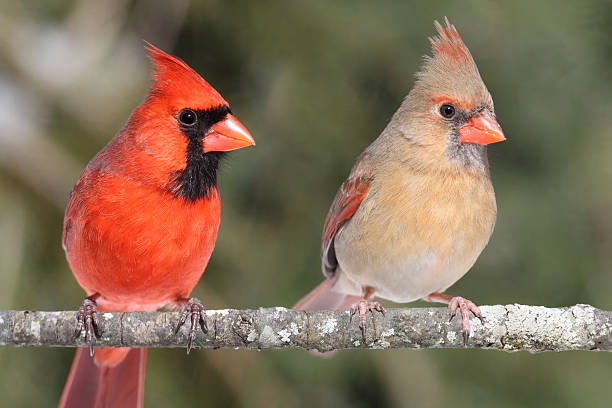
The Northern Cardinals are a common sight throughout Mississippi, making their home in the state year-round. Bird watchers have reported seeing them in 60% of their summer observations and 50% of their winter ones.
The female Northern Cardinals have a unique charm with their brown plumage, striking brown crest, and dashes of red on their beaks and bodies.
The male Northern Cardinals, on the other hand, are spectacular to behold with their vibrant red feathers and black facial markings, which stand out strikingly against a snowy winter backdrop. Like their female counterparts, they too sport red crests and beaks.
Scientific name: Cardinalis cardinalis Dimensions: 8.3-9.1 inches (21-23 cm) in length Weight: 1.5-1.7 ounces (42-48 g) Wingspan: 9.8-12.2 inches (25-31 cm)
These birds inhabit the eastern half of the United States and have extended their range as far west as Arizona in the south.
Northern Cardinals are typically found in thick vegetation where they forage for seeds, fruits, and insects. They can become quite territorial during mating season and have been known to attack their own reflection in their zeal to protect their domain.
If you’re interested in inviting Northern Cardinals into your backyard, consider setting up feeders filled with sunflower seeds, peanut hearts, millet, and milo. These birds are not picky about their feeders and will eat from large tube feeders, hoppers, platform feeders, or even food strewn on the ground.
2. Mourning Dove
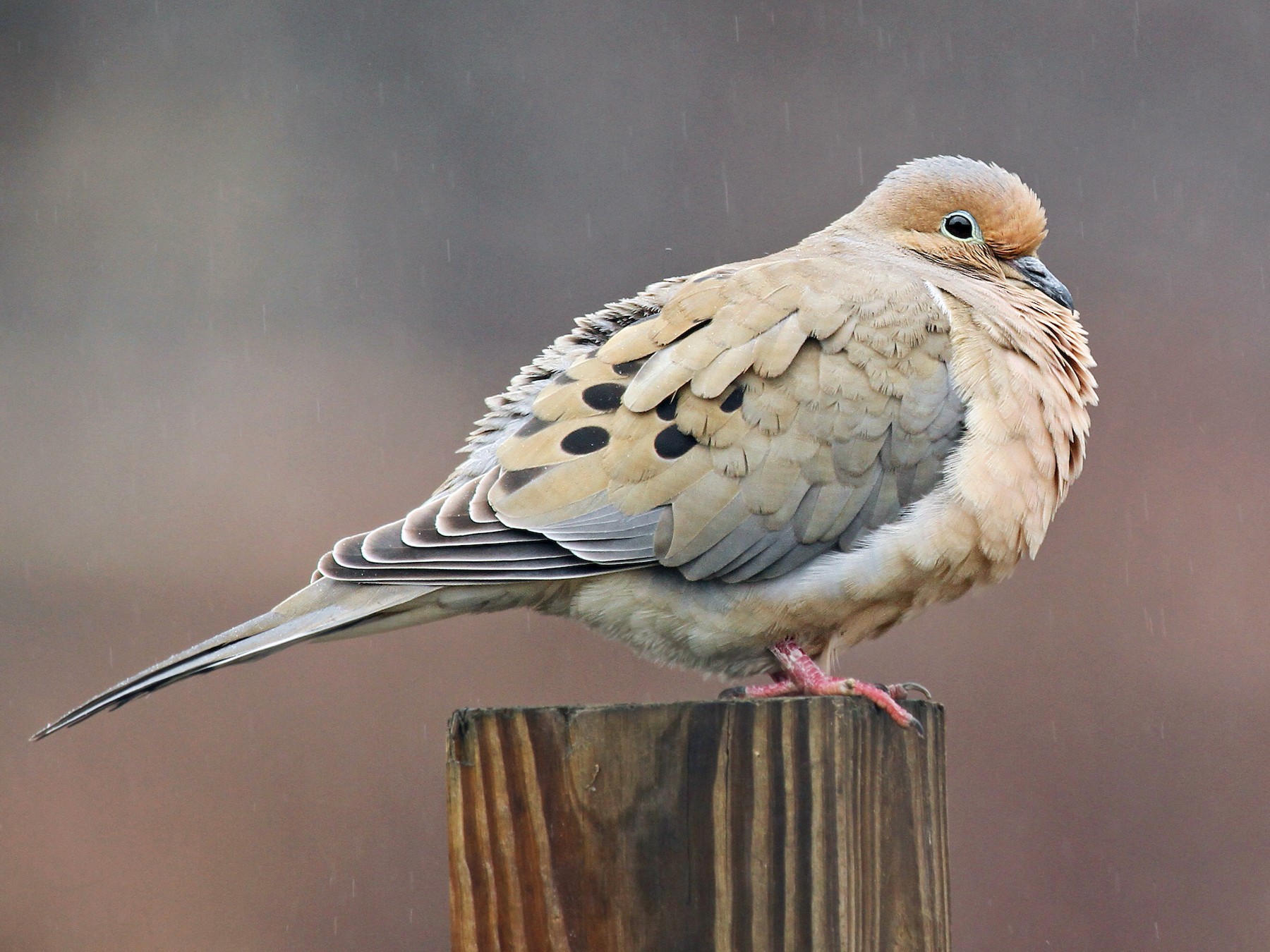
Mourning Doves are a frequent sight in Mississippi and are present throughout the year. They feature in 48% of the state’s summer bird watching records and 33% of its winter ones.
These elegant creatures have small heads, full bodies, and extended tails. Their soft brown feathers are adorned with black spots on the wings. Males generally have a slightly higher weight than females.
Scientific name: Zenaida macroura Size: 9.1-13.4 inches (23-34 cm) long Weight: 3.0-6.0 ounces (96-170 g) Wingspan: approximately 17.7 inches (45 cm)
Mourning Doves can be found across all lower 48 states year-round, although some may migrate from the northern parts of the Midwest and southern Canada after breeding season.
These birds are often seen perched on telephone wires or searching for seeds on the ground in open grasslands, fields, and residential backyards. They also inhabit open regions or the outskirts of woodlands.
To draw Mourning Doves to your yard, scatter millet on the ground or on platform feeders. They’re also partial to black sunflower seeds, nyjer, cracked corn, and peanut hearts.
3. Carolina Wren

Carolina Wrens, which are non-migratory, are often seen in Mississippi. They’re reported in 42% of summer birdwatching tallies and 34% of winter ones.
These timid birds boast a dark brown coloration on their backs and a lighter brown on their underbellies. Their distinctive features include a white eyebrow stripe, an upright tail, and a resonant ‘teakettle’ song they love to sing.
Scientific name: Thryothorus ludovicianus Size: 4.7-5.5 inches (12-14 cm) long Weight: 0.6-0.8 ounces (18-22 g) Wingspan: roughly 11.4 inches (29 cm)
Carolina Wrens can be found year-round in the eastern and southeastern United States, making homes in forests or densely vegetated regions. They’re also known to frequent backyard feeders.
To invite Carolina Wrens to your backyard feeders, try using suet feeders, hulled sunflower seeds, or peanut hearts in large tube feeders or on platform feeders.
While some species of Wrens in Mississippi are easily spotted in backyards, sighting others might require a trek to marshy regions.
4. Eastern Towhee

Eastern Towhees, known for their year-round residency in Mississippi, appear in 27% of summer birdwatching lists and 18% of those compiled during winter.
These impressive large sparrows, comparable in size to Robins, are characterized by their black heads, throats, and backs, along with reddish flanks, elongated tails, and white bellies in males. The females exhibit similar features, albeit with brown replacing the black.
Scientific name: Pipilo erythrophthalmus Size: 6.8-8.2 inches (17.3-20.8 cm) long Weight: 1.1-1.8 ounces (32-52 g) Wingspan: ranges from 7.9 to 11.0 inches (20-28 cm)
Eastern Towhees inhabit the southeastern states of the US all year round, but those living in the northern regions tend to migrate southward during winter.
These birds are typically found scouring the underbrush and the peripheries of forests and thickets.
Eastern Towhees usually build their nests on the ground, camouflaged within fallen leaves. These nests are constructed from twigs, bark, and leaves, and are lined with soft grass and animal hair. They lay up to six eggs that take just under two weeks to hatch, with fledging taking roughly the same amount of time.
To attract Eastern Towhees to your backyard, consider maintaining overgrown borders and setting up platform feeders filled with black oil sunflower seeds, hulled sunflower seeds, cracked corn, and millet.
5. Brown Thrasher
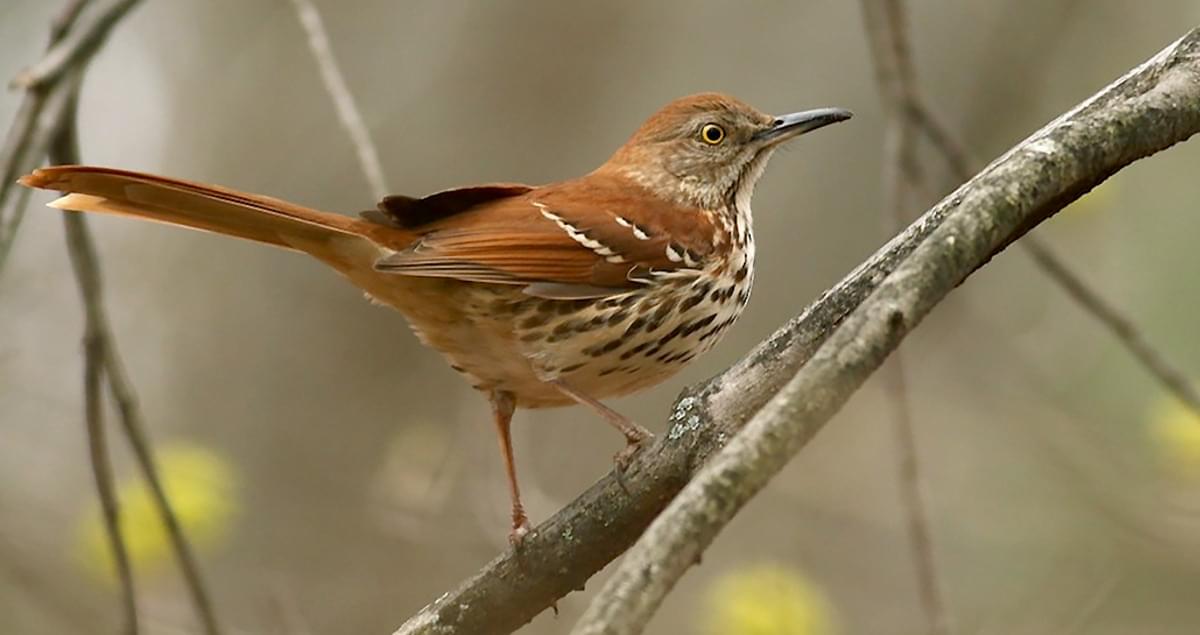
Brown Thrashers are a common sight in Mississippi throughout the year, featuring in 26% of summer bird-watching reports and 10% of winter ones.
These large, melodious birds have a similar size to robins, showcasing long bodies. They exhibit a brown back and white underparts streaked with brown. Their faces are gray, complemented by striking yellow eyes.
Scientific name: Toxostoma rufum Size: 9.1-11.8 inches (23-30 cm) long Weight: 2.1-3.1 ounces (61-89 g) Wingspan: 11.4-12.6 inches (29-32 cm)
Brown Thrashers are inhabitants of central and eastern North America. Those residing in the southeastern part of their range are year-round dwellers, while their northern counterparts tend to migrate south in the winter.
Despite their size, Brown Thrashers are elusive due to their preference for thickets and shrubs. However, their presence can be deduced from the rustling sounds they make while foraging in leaf litter and soil for insects. They also consume berries, beetles, and snatch flying insects from the air.
These birds are known for their remarkable singing ability, capable of producing over 1000 different song types – one of the most extensive repertoires among North American songbirds.
To lure Brown Thrashers to your backyard, maintain dense foliage and berry shrubs. They are also known to gather fallen seeds from beneath feeders.
6. American Robin

American Robins are year-round inhabitants of northern Mississippi, though they are more commonly seen from December through March. They feature in 14% of summer bird-watching tallies and 28% of those conducted during winter in the state.
These birds are frequently observed on lawns, hunting for earthworms. Their distinguishing features include black heads and backs, along with red or orange chests. American Robins are more prone to roosting in trees during winter, which means they’re more likely to be spotted in backyards come springtime.
Scientific name: Turdus migratorius Size: 7.9-11.0 inches (20-28 cm) long Weight: 2.7-3.0 ounces (77-85 g) Wingspan: ranges from 12.2 to 15.8 inches (31-40 cm)
American Robins can be found across the lower 48 states and along the western coastlines of Canada and Alaska. Those that breed in the interiors of Canada and Alaska typically migrate southward when winter sets in.
These birds are versatile in terms of their habitat preferences, which include woodlands, forests, mountainous regions, fields, parks, and lawns. Their diet consists of earthworms, insects, snails, and various fruits.
To attract American Robins to your backyard, consider setting up platform feeders filled with sunflower seeds, suet and peanut hearts, fruit, and mealworms. Scattering food on the ground can also work. Additionally, planting native berry-producing plants such as juniper, sumac, hawthorn, and dogwood might prove enticing.
7. House Finch – Female
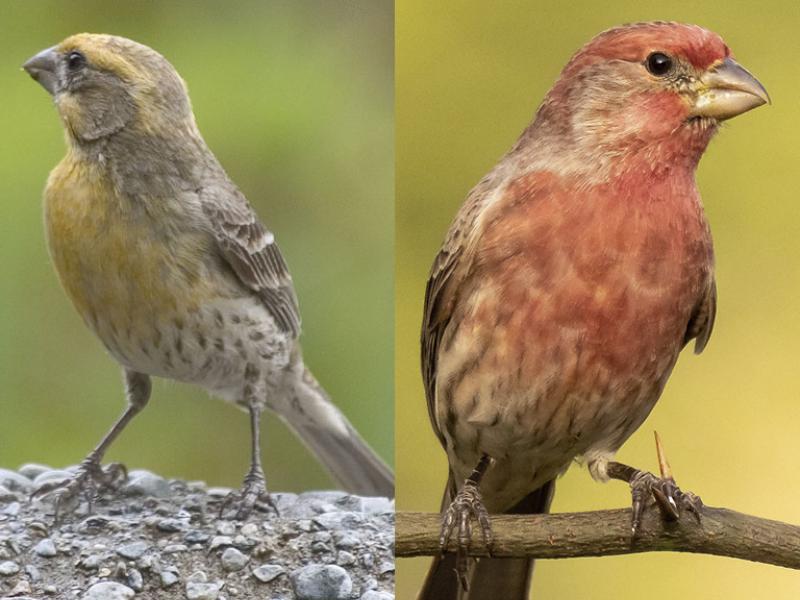
House Finches are a constant presence in Mississippi throughout the year. They do not migrate, making an appearance in 19% of summer bird-watching lists and 16% of winter ones.
Female House Finches display brown streaks all over their bodies, while males are distinguished by their red heads and chests, with the rest of their bodies primarily showcasing brown streaks.
Scientific name: Haemorhous mexicanus Size: 5.1-5.5 inches (13-14 cm) long Weight: 0.6-0.9 ounces (16-27 g) Wingspan: 7.9-9.8 inches (20-25 cm)
House Finches, originally only found in the western states of the US, were introduced to the eastern states where they have thrived, even displacing the Purple Finch in some areas.
These birds are commonly found in parks, farms, edges of forests, and backyard feeders. Their noisy groups are a hard-to-miss feature.
To attract House Finches to your backyard feeders, consider using black oil sunflower seeds or nyjer seeds in tube or platform feeders.
8. White-throated Sparrow

White-throated Sparrows are a common sight in Mississippi during the winter months, featuring in 26% of bird-watching checklists from October through May.
These birds are distinguished by their black and white striped heads, striking white throats, and yellow patches between their eyes and bills. Their backs display a brown hue, while their undersides are gray.
Scientific name: Zonotrichia albicollis Size: 6.3-7.1 inches (16-18 cm) long Weight: 0.8-1.1 ounces (22-32 g) Wingspan: 7.9-9.1 inches (20-23 cm)
White-throated Sparrows are migratory creatures, primarily breeding in Canada and then traveling south to the eastern and southern United States and the Pacific Coast during the winter.
These birds are typically found on the ground in forests and woodland areas, often congregating in large groups along the edges of wooded regions.
Their diet primarily consists of seeds from grasses and weeds, and various fruits including grapes, sumac, mountain ash, blueberries, blackberries, and dogwood. They also forage for insects on the forest floor, especially during the summer months.
To attract White-throated Sparrows to your backyard, try using millet and black oil sunflower seeds on platform feeders.
9. Eastern Phoebe
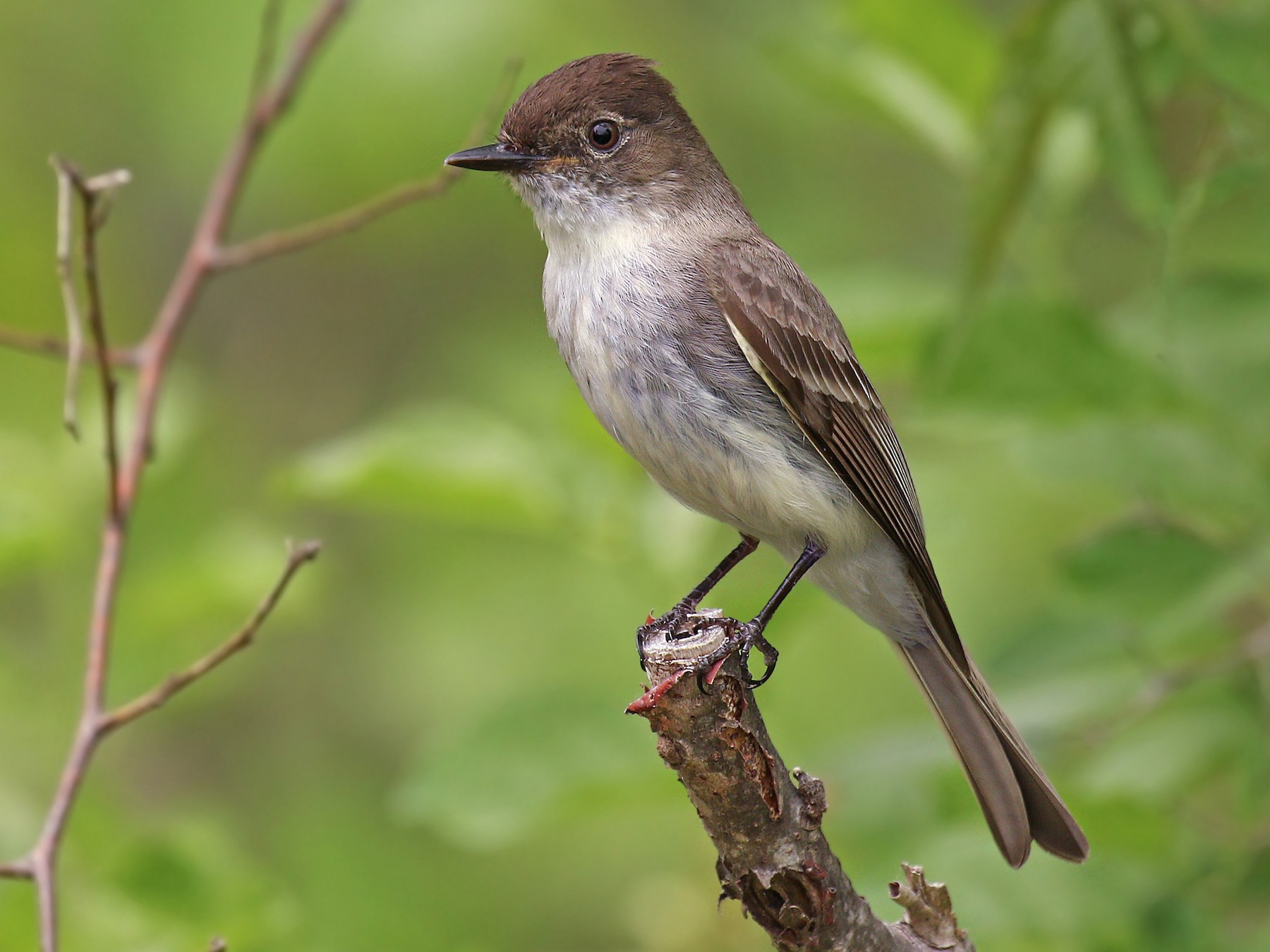
Eastern Phoebes can be seen in Mississippi throughout the year, with a noticeable increase in their numbers from October to March. They feature in 5% of summer bird-watching checklists and 20% of winter ones.
These robust songbirds are characterized by their grayish-brown backs and whitish underparts, complemented by a darker head.
Scientific name: Sayornis phoebe Size: 5.5-6.7 inches (14-17 cm) long Weight: 0.6-0.7 ounces (16-21 g) Wingspan: 10.2-11.0 inches (26-28 cm)
Eastern Phoebes are migratory creatures that breed across the northeastern and central US states, extending into Canada. Come winter, they migrate to the southeastern US states and Mexico. Some of these birds might choose to stay throughout the year in the southern parts of their range.
Eastern Phoebes are typically solitary, often seen alone in serene woodlands, where they are known to wag their tails from low perches, rather than congregating in pairs or groups.
Being flycatchers, their diet primarily consists of flying insects, although they also consume spiders, other insects, small fruits, and seeds. Their nests, made of mud and grass, are often found on bridges, barns, or residential houses.
To attract Eastern Phoebes to your backyard, consider installing a nest box or planting native plants that produce berries.
10. Brown-headed Cowbird – Female
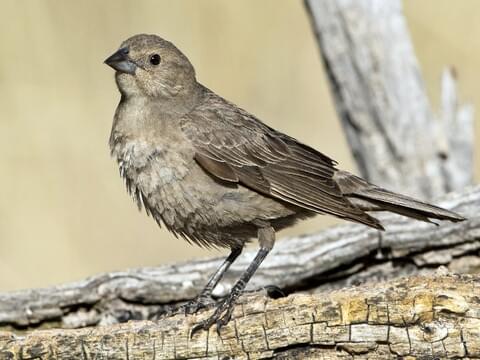
Brown-headed Cowbirds are frequently observed in Mississippi during the summer months, from February to July, although some reside in the state throughout the year. They are recorded in 20% of summer bird-watching lists and 7% of winter ones.
Female Brown-headed Cowbirds exhibit an overall brown hue with slight streaks, while males, which are larger, are characterized by their black bodies, brown heads, and short tails.
Scientific name: Molothrus ater Size: 7.6-8.7 inches (19-22 cm) long Weight: 1.3-1.8 ounces (42-50 g) Wingspan: 14.2 inches (36 cm)
Brown-headed Cowbirds are year-round inhabitants of the eastern and southern US states, as well as along the Pacific Coast. However, those breeding in the northern and western US states, as well as Canada, migrate south during the winter season.
These birds are often viewed as pests due to their parasitic nature. They tend to destroy the eggs of smaller songbirds, subsequently laying their own eggs in the ravaged nests, causing the host bird to unwittingly raise their offspring.
11. American Goldfinch – Female

American Goldfinches are predominantly observed in southern Mississippi during the winter months, though a few remain year-round in the northern part of the state. They appear in 3% of the state’s summer bird-watching records and 25% of winter ones.
American Goldfinches are cherished birds, with the males’ vivid yellow and black plumage standing out in spring. The females, as well as the males during winter, display a more subdued brown coloration.
Scientific name: Spinus tristis Size: 4.3-5.1 inches (11-13 cm) long Weight: 0.4-0.7 ounces (11-20 g) Wingspan: 7.5-8.7 inches (19-22 cm)
American Goldfinches inhabit most of North America and typically stay in one place throughout the year. However, those that breed in Canada and the Midwest often migrate to the southern US states for the winter.
These birds are often found foraging in fields overrun with weeds and in areas rich with sunflower, thistle, and aster plants. They’re also a common sight in suburban areas, parks, and backyards.
You can attract American Goldfinches to your backyard by planting thistles and milkweed. They’re known to visit a variety of bird feeders, showing a particular preference for sunflower seeds and nyjer seeds.
12. House Sparrow

House Sparrows, which are an introduced species, are present throughout the year in Mississippi. They’re non-migratory birds, appearing in 13% of the state’s summer bird-watching records and 11% of winter ones.
Having adapted well to their introduced habitats, House Sparrows are now among the most frequently sighted birds. They have heads of gray and brown, white cheeks, black and brown backs, and gray bellies.
Scientific name: Passer domesticus Size: 5.9-6.7 inches (15-17 cm) long Weight: 0.9-1.1 ounces (27-30 g) Wingspan: 7.5-9.8 inches (19-25 cm)
House Sparrows can be found year-round in the United States and southern Canada. They’re commonly seen around human habitation, displaying a high level of comfort with people to the point of feeding directly from hands.
Their diet mainly consists of grains, seeds, and discarded human food. Despite being non-native and occasionally viewed as a nuisance, they’re common visitors to backyards even without bird feeders.
To attract House Sparrows to your backyard, you can provide a variety of birdseeds, including millet, corn, and sunflower seeds.
13. Chipping Sparrow
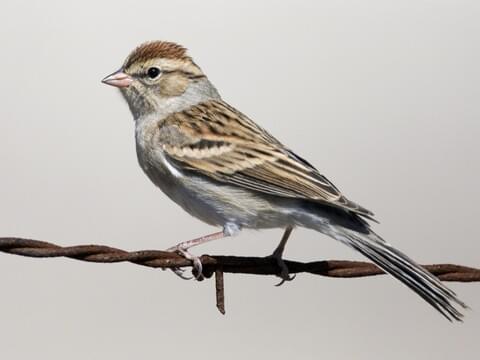
Chipping Sparrows are a familiar sight in Mississippi throughout the year, but they are particularly prevalent during the winter months, from November to April. They are noted in 7% of bird-watching records in the summer and 15% during the winter season.
Chipping Sparrows are elongated, thin birds characterized by their gray bellies and backs adorned with brown and black streaks. They sport a distinctive rusty cap and black line running through their eyes. However, their colors become more muted during the winter months.
Scientific Name: Spizella passerina Size: 4.7-5.9 inches (12-15 cm) in length Weight: 0.4-0.6 ounces (11-16 g) Wingspan: 8.3 inches (21 cm)
During the summer breeding season, Chipping Sparrows inhabit the US and Canada. When winter arrives, they migrate south to warmer climates in Mexico and Florida, while some choose to stay year-round in the southern states.
Chipping Sparrows can often be spotted in small groups in open areas and are frequent visitors to backyards, attracted by various types of birdseed.
To entice Chipping Sparrows to your backyard, provide seeds or cracked corn on easily accessible feeders like hoppers or platforms.
14. Northern Flicker
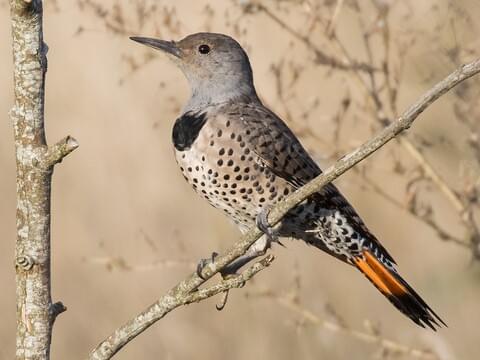
Northern Flickers, large brown woodpeckers adorned with black spots, are a common sight in Mississippi throughout the year, although they are more frequently observed during the winter months. They are documented in 4% of birdwatching logs in the summer and 13% in the winter.
Notable features of Northern Flickers include a distinct white patch visible on their rump during flight and a red patch at the back of the neck in males. Depending on their geographic origin, these birds showcase red or yellow flashes in their wings and tail. Those hailing from the western regions are typically red-shafted, while the ones from the eastern regions are yellow-shafted.
Scientific Name: Colaptes auratus Size: 11.0-12.2 inches (28-31 cm) in length Weight: 3.9-5.6 ounces (110-160 g) Wingspan: 16.5-20.1 inches (42-51 cm)
Northern Flickers are year-round residents across the US and spend their summers in Canada. However, those breeding in Canada migrate southwards when winter sets in.
Northern Flickers primarily feast on ants and beetles, supplemented by fruits and seeds. They can frequently be seen on the ground, using their curved bill to dig for food.
To draw Northern Flickers into your backyard, consider offering suet at your feeders. Moreover, you might also attract other woodpecker species prevalent in Mississippi.
15. Great-crested Flycatcher
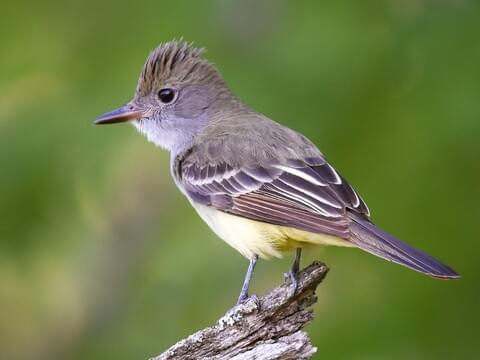
Great Crested Flycatchers, identifiable by their brown backs, yellow bellies, and gray throats, are usually found in Mississippi during their breeding season, which extends from mid-March to October. These birds feature in approximately 25% of the state’s summer birdwatching reports.
Their namesake crest is often inconspicuous, but their tail and wing feathers display a noticeable reddish tinge.
Scientific Name: Myiarchus crinitus Size: 6.7-8.3 inches (17-21 cm) in length Weight: 0.9-1.4 ounces (27-40 g) Wingspan: 13.4 inches (34 cm)
The Great Crested Flycatchers’ breeding territory encompasses much of eastern North America. Come winter, they migrate to warmer regions like southern Florida, southern Mexico, and Central America.
These birds favor perching high in the trees in woodland areas, vigilantly waiting to catch large insects such as butterflies, grasshoppers, moths, wasps, and spiders. Their habitats include mixed forests, the peripheries of clearings, parks, and tree-lined neighborhoods. They’re also known to perch on man-made structures like fenceposts. Their diet is occasionally supplemented with berries and small fruits.
To invite Great Crested Flycatchers into your backyard, consider planting native plant species and maintaining brush piles to lure insects. You can also plant fruit-bearing flora and install a nest box, as these birds are known to readily inhabit such structures.
16. Common Yellowthroat
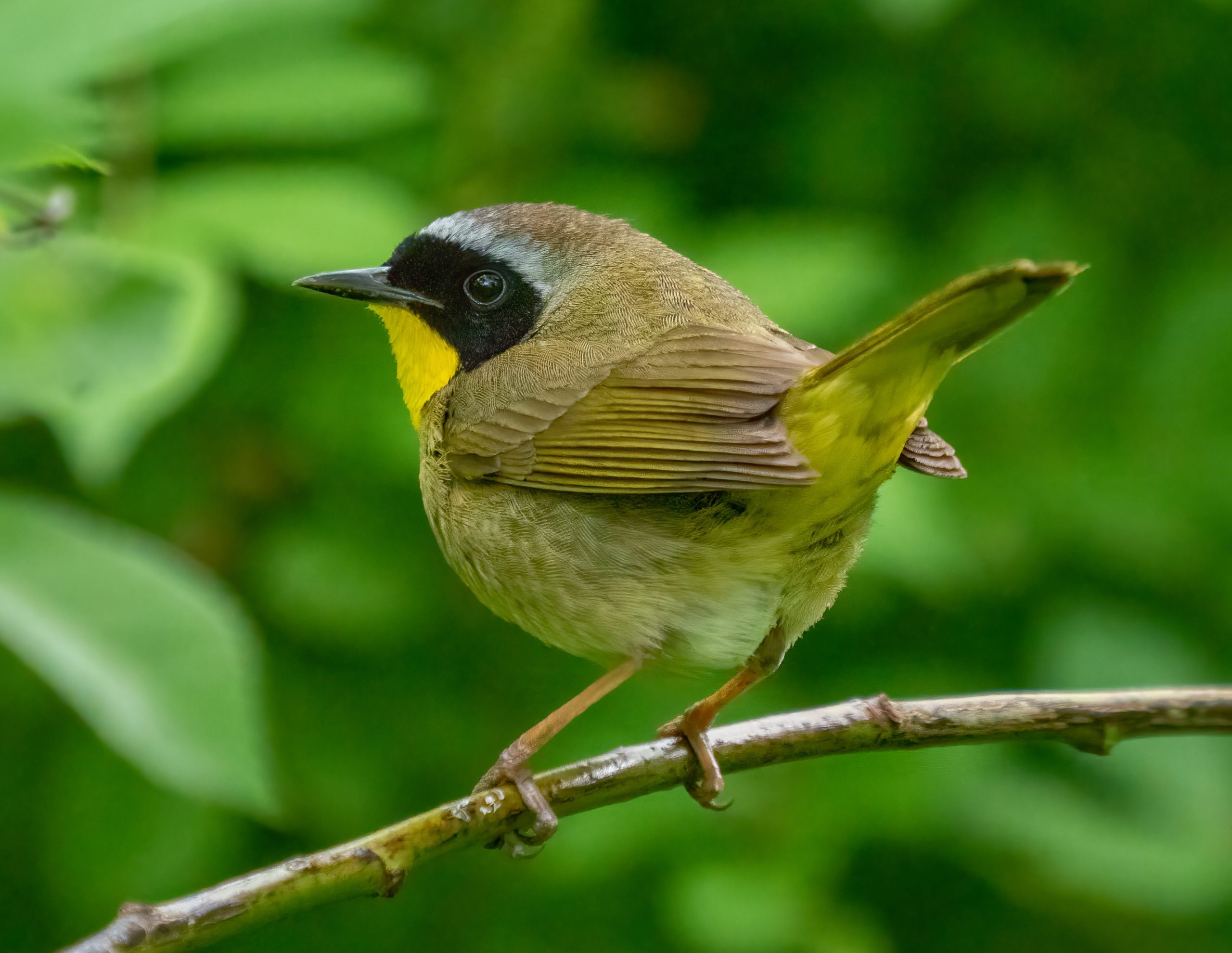
Common Yellowthroats are small songbirds that can be sighted throughout the year in the southern part of Mississippi, but they’re more visible in the northern regions during the breeding season. They feature on 15% of the state’s summer birdwatching checklists and 3% of those compiled in winter.
These birds sport a brownish back and a vivid yellow underbelly, complemented by a lengthy tail. The males are distinguishable by a black mask that spans their faces. The intensity of their yellow coloration can vary based on their geographical location, and some may exhibit an olive hue in certain regions.
Scientific Name: Geothlypis trichas Size: 4.3-5.1 inches (11-13 cm) in length Weight: 0.3-0.3 ounces (9-10 g) Wingspan: 5.9-7.5 inches (15-19 cm)
Common Yellowthroats spend the summer breeding season across most of North America, with the exception of Alaska and northern Canada. Some of these birds choose to stay year-round along the Gulf Coast and in the Pacific Southwest, while others migrate south for the winter.
These birds have a fondness for marshy or wetland areas and brushy fields where they reside amidst thick, tangled vegetation.
To attract Common Yellowthroats to expansive backyards, consider planting dense vegetation and native plants to draw insects, which form a significant part of their diet.
Common Yellowthroats belong to the warbler family, and they are only one of the many fascinating species of this bird family that can be found in Mississippi. Their captivating songs are a joy to listen to and learn.
17. Swamp Sparrow

Swamp Sparrows, which appear on 12% of Mississippi’s winter birdwatching checklists, typically spend their winters in the state, spanning from September through May.
These birds are distinguishable by their dark brown backs and rusty-hued crowns and wings. They have gray chests and white throats, complemented by gray heads, brown faces with a distinct dark line around their eyes, and a yellow tip on their beaks.
Scientific Name: Melospiza georgiana Size: 4.7-5.9 inches (12-15 cm) in length Weight: 0.5-0.8 ounces (15-23 g) Wingspan: 7.1-7.5 inches (18-19 cm)
Swamp Sparrows are more prevalent in the eastern regions. Their breeding grounds extend from Canada to the northeastern and north-central US states. After the breeding season, they migrate to eastern and southern US states and Mexico.
Living up to their names, Swamp Sparrows can primarily be found in wetland habitats, including swamps, bogs, and coastal marshes. Their diet consists largely of seeds and fruit, particularly during the winter months, while insects make up a bigger portion of their meals in spring.
Swamp Sparrows typically construct their nests concealed within vegetation, near or directly on the ground. These nests are made from twigs, leaves, and cattails and lined with grass and other plant materials.
These birds are not frequent backyard visitors, but they may venture into yards with abundant vegetation and water sources during their migration.
18. Cedar Waxwing

Cedar Waxwings are primarily spotted in Mississippi during the colder months, from October through May, featuring in about 8% of the birdwatching checklists during this period.
These graceful, sociable birds present a pale brown hue on their heads, chests, and crests, transitioning to a gray tone on their backs, wings, and tails. They sport a pale yellow underbelly that intensifies to a bright yellow near their tails. Notably, they have a slender black mask over their eyes and striking red spots on their wingtips.
Scientific Name: Bombycilla cedrorum Size: Ranging between 5.5 to 6.7 inches (14-17 cm) in length Weight: Approximately 1.1 ounces (32 g) Wingspan: Extending from 8.7 to 11.8 inches (22-30 cm)
Cedar Waxwings are permanent residents in the northern half of the United States. However, those that breed in Canada typically migrate to the southern half of the US for the winter season.
Recognizable by their high-pitched calls, these birds can often be found in areas with berry bushes, woodlands, and near streams.
Attract Cedar Waxwings to your backyard by planting native trees and shrubs that produce small fruits, such as serviceberry, dogwood, juniper, winterberry, and hawthorn. Additionally, you can entice them with fruit placed on platform feeders.
19. Song Sparrow

From October through May, Song Sparrows make Mississippi their winter abode, and they can be spotted in about 14% of winter bird sightings.
Though their appearance might not be as striking as other backyard birds, these birds, predominantly brown with streaked patterns, stand out due to their near-constant melodious songs that they use to attract mates during the spring and summer seasons.
Scientific Name: Melospiza melodia Dimensions: Between 4.7-6.7 inches (12-17 cm) long Weight: Ranges from 0.4-1.9 oz (12-53 g) Wingspan: Extends between 7.1-9.4 inches (18-24 cm)
Song Sparrows are year-round inhabitants of the northern US states. Those that breed in Canada migrate south to the US for the winter.
These birds favor open, shrubby, and wet areas, often spotted perched on a low shrub while singing. They also frequently visit backyard feeders.
The diet of Song Sparrows is quite diverse, including a wide range of insects and plants such as beetles, caterpillars, midges, spiders, and earthworms. They also enjoy buckwheat, sunflower seeds, raspberries, wild cherries, blackberries, wheat, and rice.
To lure Song Sparrows to your backyard feeders, you can use black oil sunflower seeds, cracked corn, and nyjer seeds, preferably on platform feeders.
Interestingly, a considerable variety of sparrows can be seen in Mississippi. By learning their unique songs and fun facts, you can more easily identify these birds.
20. Wood Thrush

Wood Thrushes, frequently sighted in Mississippi during the breeding season from mid-March to October, appear in 12% of the checklists during this period.
Wood Thrushes are somewhat amusing to look at, thanks to their plump bellies featuring white and black spots. They have a brown back, with a crown and upper back showing reddish tints.
Scientific Name: Hylocichla mustelina Size: Measures from 7.5 to 8.3 inches (19-21 cm) in length Weight: Ranges from 1.4 to 1.8 oz (40-50 g) Wingspan: Spans from 11.8 to 13.4 inches (30-34 cm)
Wood Thrushes undertake a significant migration, traveling from the eastern states of the US across the Gulf of Mexico and landing in Central America, all within a single night.
Preferring to stay concealed, these birds forage in leaf litter for insects like beetles and flies in mature forests. When spring arrives, you can hear their characteristic ‘flute-like’ song echoing in the woods.
21. Savannah Sparrow

Savannah Sparrows make their winter abode in Mississippi, gracing the state from mid-September until May. They feature in approximately 8% of winter bird-watching checklists.
Upon closer observation, you’ll notice that this otherwise brown bird carries a unique yellow patch near its eye. Savannah Sparrows are characterized by their short tails and streaked brown plumage.
Scientific name: Passerculus sandwichensis Size: Their length ranges from 4.3 to 5.9 inches (11-15 cm) Weight: They weigh between 0.5 and 1.0 oz (15-28 g) Wingspan: Their wingspan measures from 7.9 to 8.7 inches (20-22 cm)
Savannah Sparrows are breeders in Canada and the US, migrating southwards to the southern US states and Mexico when winter sets in.
These birds are typically seen on the ground in open areas like grasslands, where they forage for insects and spiders during breeding season, shifting to seeds in the winter.
Savannah Sparrows build their nests on or close to the ground, using grass as their primary construction material. They lay up to six eggs which incubate for about two weeks. After hatching, the fledglings take another one to two weeks to leave the nest.
Although these birds aren’t frequent visitors to bird feeders, they might pay a visit to your yard if it has brush piles, tall grass, and is located near fields.
22. House Wren

House Wrens are most commonly sighted during the winter season in Mississippi, making an appearance in about 4% of winter bird-watching checklists.
These small birds are typically brown, with darker-hued wings and tails that are streaked, and a lighter throat. They are often seen with their tails held high.
Scientific name: Troglodytes aedon Size: They measure between 4.3 and 5.1 inches (11-13 cm) in length. Weight: Their weight ranges from 0.3 to 0.4 oz (10-12 g). Wingspan: They possess a wingspan of 5.9 inches (15 cm).
House Wrens usually breed in the US and southern parts of Canada during the summer season before they migrate to the southern US states and Mexico for the winter.
You can often spot these birds in backyards, public parks, and open woods, where they forage for insects and spiders. They’re known for their dynamic hopping movements through low branches and tangles, often punctuated by their cheerful song.
Despite their small size, House Wrens are remarkably assertive when it comes to securing prime nesting sites. They’ve been known to intimidate larger birds and may even remove eggs or young chicks from a nest they desire.
To make your backyard more attractive to House Wrens, consider leaving brush piles or setting up a nest box.
23. Pine Siskin
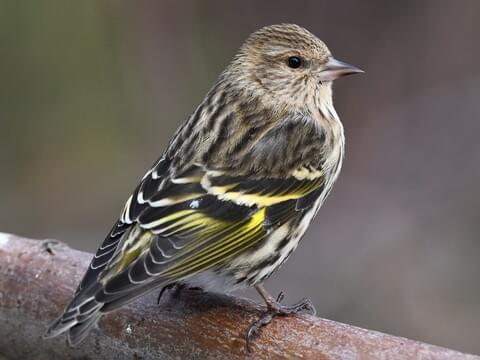
Pine Siskins are typically spotted in Mississippi during the winter months, beginning in September and sometimes remaining until May. They appear in approximately 5% of the winter bird-watching checklists.
These petite brown finches are characterized by yellow streaks on their wings and tail. They have a forked tail, pointed wings, and a short, sharp bill.
Scientific name: Spinus Pinus Size: They measure between 4.3 and 5.5 inches (11-14 cm) in length. Weight: Their weight ranges from 0.4 to 0.6 oz (12-18 g). Wingspan: They have a wingspan of 7.1 to 8.7 inches (18-22 cm).
Pine Siskins can be found all year round in the pine forests of the western states and along the Canadian border. Some also breed in Canada before migrating south for the winter.
The birds’ geographic distribution across North America largely depends on the yield of pine cone crops. As suggested by their name, Pine Siskins primarily feed on seeds from coniferous trees, but they will also consume young buds as well as seeds from grasses and weeds.
To attract Pine Siskins to your backyard, consider using thistle and nyjer feeders. They’re also attracted to black oil sunflower seeds and suet.
24. Marsh Wren
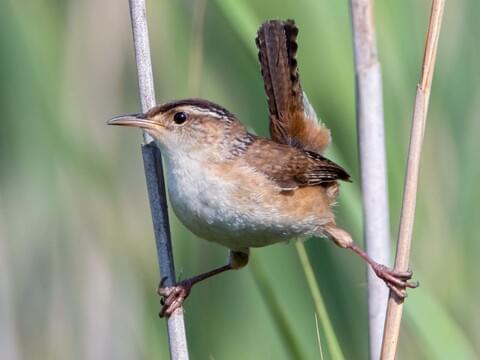
Marsh Wrens are more commonly observed in Mississippi during the winter months, although some are present throughout the year. They are noted in about 3% of winter bird-watching logs.
Marsh Wrens exhibit a brown plumage with black and white streaks along their backs. Their undersides are a grayish-brown hue, and they possess the characteristic upright tail typical of wrens. There is no discernible difference in appearance between males and females.
They bear resemblance to Sedge Wrens but can be distinguished by their lack of stripes on their shoulders and their longer beaks.
Scientific Name: Cistothorus palustris Size: They measure between 3.9 and 5.5 inches (10-14 cm) in length. Weight: Their weight ranges from 0.3 to 0.5 oz (9-14 g). Wingspan: They have a wingspan of approximately 5.9 inches (15 cm).
Marsh Wrens spend the breeding season in the northern US states and central regions of Canada before migrating to the southern US states and Mexico. Some individuals in the western US and along the Atlantic coast remain stationary throughout the year. During their migration, they can be seen in the eastern US.
These birds are typically found in wetland areas, where they can be seen gripping onto reeds with each foot holding a separate stalk. Although they may be challenging to spot, their singing amongst the reeds, particularly at dawn and dusk, can help reveal their presence. Their diet primarily consists of insects and spiders that they pluck from leaves near the water.
The nests built by Marsh Wrens are fully enclosed, save for a small opening at the top. These nests are constructed from interwoven reeds and grasses.
25. Hermit Thrush

The Hermit Thrush is a winter resident in Mississippi and features on about 5% of birdwatchers’ checklists during this period. Their main sightings occur between October and April.
Hermit Thrushes are notable for their upright posture, robust bodies, and elongated tails. Their backside showcases a brown color, while their underparts are white, punctuated by speckles on their throat and chest.
Scientific Name: Catharus guttatus Size: Their length ranges from 5.5 to 7.1 inches (14-18 cm). Weight: They weigh between 0.8 and 1.3 oz (23-37 g). Wingspan: They boast a wingspan measuring 9.8 to 11.4 inches (25-29 cm).
Hermit Thrushes breed in Canada, the northeastern United States, and the western part of the country. During their migration, they can be spotted in central states before wintering along the Pacific Coast, the southeastern states, and Mexico.
These birds scavenge on the ground within forest clearings, rummaging through leaf litter in search of insects. Their winter diet includes berries as well.
Hermit Thrushes are not frequent backyard visitors, but their somewhat melancholic song can be heard during the spring and summer months.
26. Rose-breasted Grosbeak – Female
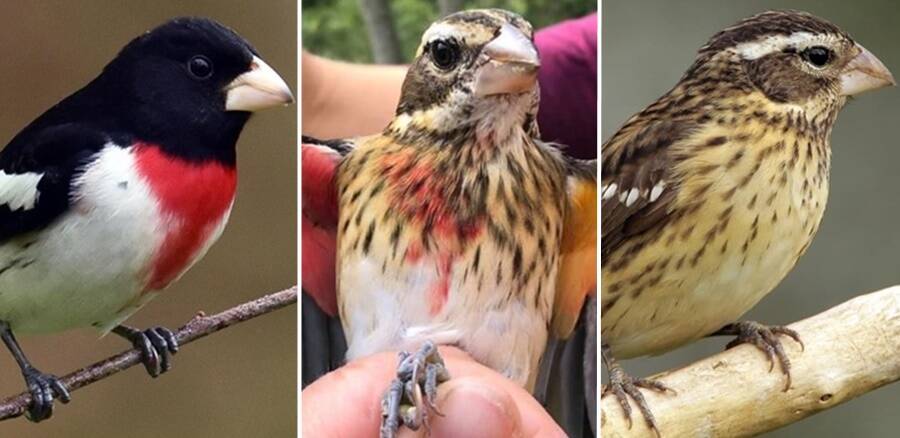
Rose-breasted Grosbeaks are typically observed in Mississippi during their migratory periods, particularly from April to May and again from September to December. They show up in approximately 21% of spring birdwatching checklists and 7% of fall checklists.
Female and young male Rose-breasted Grosbeaks exhibit a brown hue with distinct streaks and a hint of yellow under their wings.
The male Rose-breasted Grosbeaks, however, are primarily black and white, with black heads and backs, white bellies, and vivid red chests. A streak of red under their wings also adds to their striking appearance.
Scientific Name: Pheucticus ludovicianus Dimensions: They measure between 7.1 and 8.3 inches (18-21 cm) in length. Weight: Their weight ranges from 1.4 to 1.7 oz (39-49 g). Wingspan: They boast a wingspan of 11.4 to 13.0 inches (29-33 cm).
The breeding grounds of the Rose-breasted Grosbeaks include northeastern and midwestern US states, along with southern and central Canada. During migration, they can be observed in the southeastern states of the US. They spend their winters in Mexico, Central America, and the Caribbean.
Rose-breasted Grosbeaks can be found in various habitats, including forests, parks, and backyards, where they forage for insects, berries, and seeds.
Their nests, usually situated on the branches of a low-lying tree, are made up of loosely arranged twigs, grass, and plant material. They lay around five eggs, which take about two weeks to hatch, with both parents sharing the incubation duties.
To draw Rose-breasted Grosbeaks to your backyard, consider offering sunflower seeds and peanuts.
27. Purple Finch – Female

Purple Finches are primarily observed in Mississippi during the winter season, from November to mid-May, appearing in approximately 6% of birdwatching checklists during this period.
Female Purple Finches exhibit a brown-streaked plumage all over, while males boast reddish-purple heads and chests, with more brown present on their backs and wings and a lighter belly. They bear a strong resemblance to House Finches but display a richer red hue, particularly on the upper part of their backs.
Scientific Name: Haemorhous purpureus Dimensions: They measure between 4.7 and 6.3 inches (12-16 cm) in length. Weight: Their weight ranges from 0.6 to 1.1 oz (18-32 g). Wingspan: They have a wingspan of 8.7 to 10.2 inches (22-26 cm).
Purple Finches breed in Canada and spend the winter in the eastern states of the US. However, they can be seen throughout the year in the northeastern US and along the Pacific coast.
Purple Finches can be found in evergreen forests, where they primarily feed on seeds, but they also consume buds, nectar, and berries.
Their nests, typically situated high in the trees, are constructed from twigs, bark, weeds, and moss. They usually lay three to five eggs, which are incubated by the female for about thirteen days.
To draw Purple Finches to your backyard, consider providing black oil sunflower seeds
28. Field Sparrow
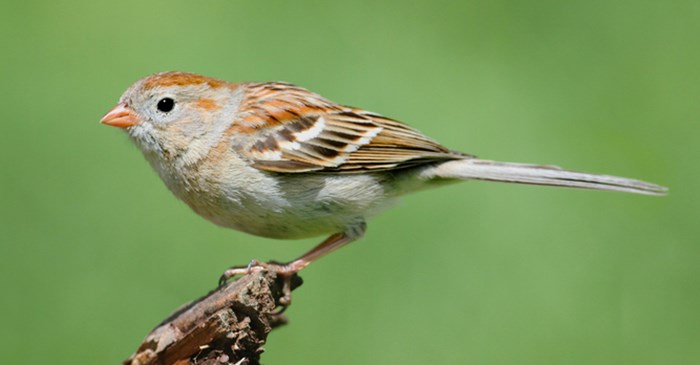
Field Sparrows are sighted all year round in Mississippi, making an appearance in approximately 2% of birdwatching checklists during both summer and winter seasons.
Field Sparrows are petite, slim birds sporting brown backs highlighted with black streaks. Their underbellies and heads are gray, and they feature a distinctive reddish crown and a pinkish beak.
Scientific Name: Spizella pusilla Dimensions: They measure between 4.7 and 5.9 inches (12-15 cm) in length. Weight: They weigh approximately 0.4 to 0.5 oz (11-15 g). Wingspan: Their wingspan is about 7.9 inches (20 cm).
Field Sparrows inhabit the eastern states of the US all year round, while those that breed in the Midwest migrate south for the winter.
During the breeding season, male Field Sparrows can be easily spotted as they sing from perches in the early morning hours. Otherwise, they quietly feed on weeds and seeds and can easily go unnoticed due to their preference for abandoned fields and their timid nature.
The nests of Field Sparrows are initially constructed on the ground for the first brood, and with each subsequent brood, the nests are built higher. The nests are woven from grass, housing up to five eggs that incubate for about two weeks. Once hatched, the fledglings take just a week to leave the nest.
To lure Field Sparrows to your backyard, consider providing cracked corn, hulled sunflower seeds, and millet.
29. Winter Wren

Winter Wrens are typically seen in Mississippi during the colder months and are noted in about 2% of birdwatching checklists during this period. Their presence is most prominent from late September until April.
Winter Wrens are petite, rotund birds featuring a brown coat with darker bars on their wings, tail, and belly. They have a lighter stripe above their eyes and short tails that they keep raised. There’s no visible difference between males and females.
Initially, Winter Wrens were thought to be the same species as Pacific Wrens due to their striking similarities, but they are now classified as separate species, largely due to the distinct songs they sing.
Scientific Name: Troglodytes hiemalis Size: They measure between 3.1 and 4.7 inches (8-12 cm) in length. Weight: They weigh approximately 0.3 to 0.4 oz (8-12 g). Wingspan: Their wingspan ranges from 4.7 to 6.3 inches (12-16 cm).
Winter Wrens inhabit the eastern US states during winter and move to northeastern US states and Canada during summer.
Winter Wrens can be found foraging amidst forest underbrush and in backyards, hidden in thick vegetation. They eat insects and spiders, which they find by rummaging through leaf litter and decaying bark.
Winter Wren nests are spherical and made from a collection of twigs, moss, and grass, with a small opening. They lay between 1 and 9 eggs, which take about two to two and a half weeks to hatch, with fledging taking a similar amount of time.
To attract Winter Wrens to your backyard, consider planting native vegetation and maintaining dense plant growth.
30. Louisiana Waterthrush
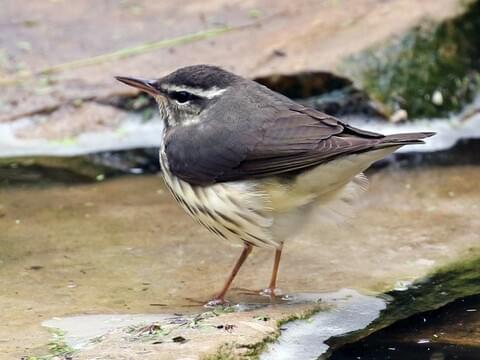
Louisiana Waterthrushes are included in about 2% of summertime birdwatching checklists. They are most commonly sighted in Mississippi from March through September.
Compared to other warbler species, Louisiana Waterthrushes might seem rather plain. They sport brown upper bodies and paler underparts. Notable features include a white stripe above their eyes and long pink legs.
Scientific Name: Parkesia motacilla Size: Their length ranges between 5.9 and 6.1 inches (15-15.5 cm). Weight: They weigh approximately 0.6 to 0.8 oz (18.2-22.9 g). Wingspan: Their wingspan extends from 9.4 to 10.6 inches (24-27 cm).
Louisiana Waterthrushes breed in the eastern United States, and they are often sighted in the southeast during their migration period. These birds winter in Mexico, Central America, and the Caribbean, returning relatively early in the spring.
Louisiana Waterthrushes can be found hunting for insects, small vertebrates, and larvae along streams and other flowing water bodies in woodland areas.
When it comes to nesting, Louisiana Waterthrushes typically build their nests along stream banks, concealed in roots or beneath logs. Constructed from leaves, pine needles, and other plant matter, these nests are bound together with mud.
31. White-crowned Sparrow

White-crowned Sparrows aren’t frequently seen in Mississippi, however, they make an appearance during winter, featuring in about 1% of birdwatching checklists during this season. They are typically sighted from October through May.
White-crowned Sparrows are sizeable, grayish birds with distinct black and white stripes adorning their heads. They have long tails and comparatively small beaks.
Scientific Name: Zonotrichia leucophrys Size: Their length is usually between 5.9 and 6.3 inches (15-16 cm). Weight: They generally weigh between 0.9 and 1.0 oz (25-28 g). Wingspan: Their wingspan ranges from 8.3 to 9.4 inches (21-24 cm).
White-crowned Sparrows breed in Alaska and the Arctic regions of Canada. Post breeding, they migrate southward to the continental US and Mexico for the winter. However, some of them choose to stay along the Pacific Coast and the mountainous regions of the west throughout the year.
White-crowned Sparrows are typically found foraging for seeds from weeds and grasses, or fruits such as elderberries and blackberries, in areas like weedy fields, roadside verges, forest fringes, and backyards.
Their nests, often situated low in shrubs or on the ground in tundra areas, are crafted from twigs, grass, moss, and pine needles. They usually lay up to seven eggs, which take about two weeks to hatch. It then takes roughly nine more days for the fledglings to leave the nest.
To attract White-crowned Sparrows to your backyard, consider providing sunflower seeds. They are also known to feed on seeds discarded by other birds at feeding stations.
32. Swainson’s Thrush
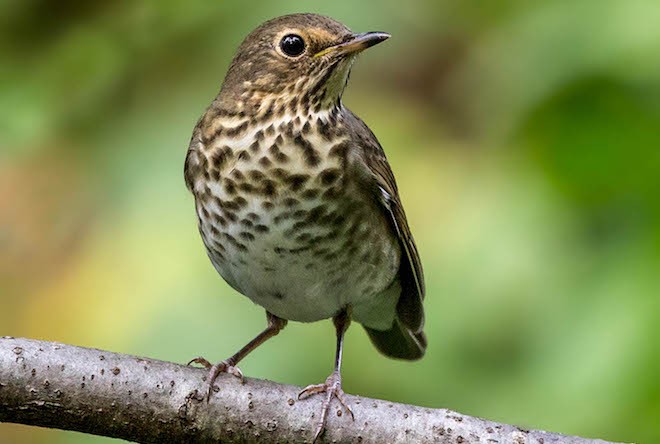
Swainson’s Thrushes are primarily observed in Mississippi during their migration periods, specifically from April to May and again from September to October. They show up in approximately 6% of birdwatching checklists in the spring, and in 2% of the checklists during the fall.
These medium-sized thrushes display a brown coloring on their backs, while their underparts are lighter with speckled chests.
Scientific Name: Catharus ustulatus Dimensions: Their length usually ranges between 6.3 and 7.5 inches (16-19 cm). Weight: They typically weigh between 0.8 and 1.6 oz (23-45 g). Wingspan: Their wingspan measures around 11.4 to 12.2 inches (29-31 cm).
Swainson’s Thrushes are often found in forested areas, foraging among fallen leaves for insects during their breeding season. Their diet also includes red fruits such as blackberries, raspberries, huckleberries, and sumac. Ants form a significant portion of their diet, and other insects are fed to their young.
These birds are typically visible in the lower 48 states only during their migration periods in spring and fall. They breed in Canada and Alaska before migrating to Central and South America for the winter.
To draw Swainson’s Thrushes into your backyard, consider installing ground-level birdbaths and providing ample tree and shrub coverage.
33. Brown Creeper
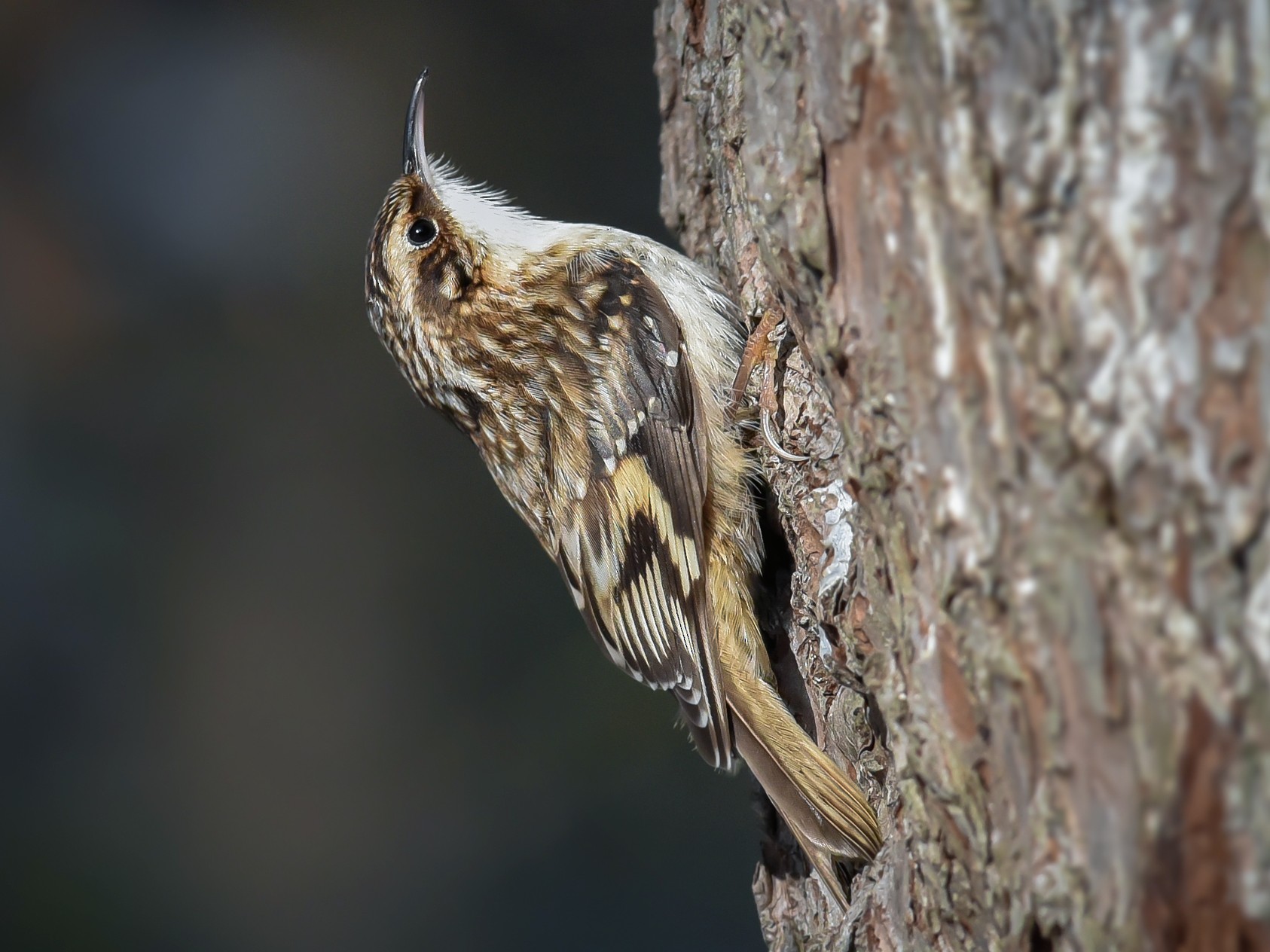
Brown Creepers are primarily observed in Mississippi between October and April, appearing in roughly 2% of winter birding checklists.
These small songbirds blend in perfectly with tree trunks due to their streaked brown backs and white bellies, making them difficult to spot.
Scientific Name: Certhia americana Dimensions: Their length usually falls between 4.7 and 5.5 inches (12-14 cm). Weight: They typically weigh between 0.2 and 0.3 oz (5-10 g). Wingspan: Their wingspan ranges from 6.7 to 7.9 inches (17-20 cm).
Brown Creepers do not typically migrate but might move to lower elevations or further south during the winter months. Their distribution covers Alaska, southern Canada, northeastern and eastern United States, extending down to Mexico and Central America. In certain winters, they also venture into central and southeastern states.
To spot these elusive birds, closely examine the trunks of mature trees in large forests where they hunt for insects and larvae concealed in the bark.
Unlike nuthatches that descend tree trunks, Brown Creepers tend to work their way upwards, always facing the tree.
These songbirds can be located by their high, piercing call rather than a traditional song.
34. Northern Waterthrush
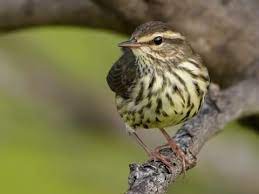
Northern Waterthrushes aren’t frequently seen in Mississippi, but they do make appearances during migration periods, typically from mid-March to May and again from August to October.
These birds, which resemble large thrushes, exhibit similar physical characteristics in both males and females. Their brown heads are adorned with bold, white eyebrows, and their dark brown backs contrast their white bellies. A distinguishing feature is the heavy dark streaking that extends from their throats down to their rumps.
Scientific Name: Parkesia noveboracensis Size: They measure about 5.75 inches (15 cm) in length. Weight: They usually weigh around 0.8 oz (23 g). Wingspan: Their wingspan extends up to approximately 8.75 inches (22 cm).
Northern Waterthrushes breed in Canada, Alaska, and the northeastern US before embarking on their migration to Mexico, Central and South America, and the Caribbean. Some individuals opt to stay year-round in Central and South America.
These birds favor dark, woodsy swamps, thicketed areas, and bogs. They are often found near still or slow-moving water in forests. During the winter months, they are typically found among mangroves in tropical regions.
As foragers in both aquatic and terrestrial environments, Northern Waterthrushes use their long legs to wade in shallow waters in search of water beetles, mosquitoes, slugs, crustaceans, snails, and occasionally small fish. They also feed on caterpillars, moths, and ants found beneath leaves.
The nests of Northern Waterthrushes are typically concealed in cavities or crevices near water, often hidden among ferns. They might be nestled in a moss-covered stump or under an overhanging bank.
35. Bewick’s Wren
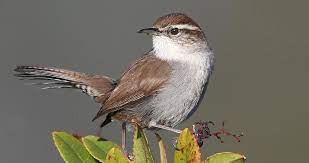
Bewick’s Wrens are considered rare visitors in Mississippi, with the latest sighting recorded back in 2019.
These birds have a brown back and a long, grey tail that’s typically held upright and displays dark barring. Their bellies are grey, and a white stripe runs over their eyes.
Scientific Name: Thryomanes bewickii Size: Their length measures around 5.1 inches (13 cm) Weight: They typically weigh between 0.3 and 0.4 ounces (8-12 grams)
Bewick’s Wrens are year-round residents of southern and western states, and they occasionally migrate within these areas during the winter season.
These birds are typically found in shrubby areas, thickets, and open woodlands, where they hop from branch to branch, flicking their long tails. Their diet primarily consists of insects and larvae, including bees, bugs, caterpillars, and beetles.
Bewick’s Wrens construct their nests on rock ledges, in old woodpecker nests, nest boxes, or crevices in buildings. Their nests are cup-shaped, crafted from sticks and grasses, and lined with softer materials. They typically lay between 3 and 8 eggs, which take approximately two weeks to hatch. The fledglings take an additional two weeks to leave the nest.
You can attract Bewick’s Wrens to your backyard by offering suet, mealworms, and hulled sunflower seeds.
36. American Tree Sparrow

American Tree Sparrows are infrequently seen in Mississippi, though a handful of winter sightings have been recorded.
These plump, long-tailed birds exhibit a brown-streaked appearance with distinctive rusty caps, grey faces, and a unique rusty line passing through their eyes.
Scientific Name: Spizelloides arborea Size: They measure around 5.5 inches (14 cm) in length. Weight: They weigh between 0.5 and 1.0 ounces (13-28 grams). Wingspan: Their wingspan measures around 9.4 inches (24 cm).
American Tree Sparrows spend their summers in Canada and their winters in the US. They breed in the northernmost parts of Canada and Alaska, migrating to the majority of US states during the winter months, excluding the Pacific and Gulf Coast regions.
These birds are commonly found foraging in small groups in weedy fields or beneath bird feeders.
The nests of American Tree Sparrows are typically located on or close to the ground and are constructed from twigs, grass, and moss. They lay around five eggs, which take just under two weeks to hatch, with the fledglings ready to leave the nest just over a week later.
You can attract American Tree Sparrows to your backyard by using platform feeders filled with black oil sunflower seeds, nyjer, cracked corn, and millet. They also enjoy feeding on seeds that have fallen to the ground from tube feeders.
37. Spotted Towhee
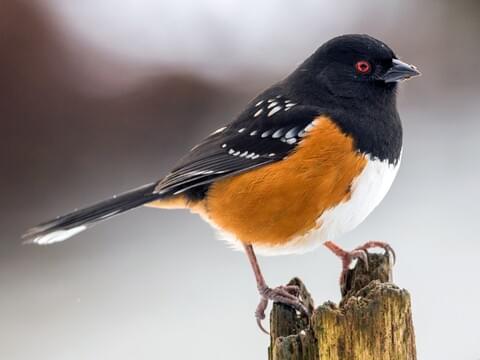
Spotted Towhees are an exceptional sight in Mississippi, being extremely scarce in this state. The most recent recorded sighting dates back to 2012.
These large sparrows are distinguishable by their black heads, throats, and backs in males, while females display a brown hue. Both genders have reddish-brown flanks and white bellies, along with distinctive white spots on their wings and backs, complemented by their long tails.
Scientific Name: Pipilo maculatus Size: They measure between 6.7 and 8.3 inches (17-21 cm) in length. Weight: They weigh from 1.2 to 1.7 ounces (33-49 grams). Wingspan: Their wingspan extends to about 11.0 inches (28 cm).
Spotted Towhees inhabit the western regions of the US. However, those that reside further inland in the north migrate southwards towards Texas after their breeding season.
These birds can typically be found rummaging in dense shrubbery, foraging for insects such as beetles, crickets, grasshoppers, caterpillars, wasps, and bees. They also feed on acorns, berries, and seeds.
If you want to attract Spotted Towhees to your yard, maintain overgrown borders as they prefer such environments. They will also frequent platform feeders or ground feeders stocked with Black Oil Sunflower seeds, Hulled Sunflower seeds, Cracked Corn, Millet, and Milo.
